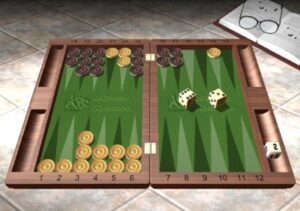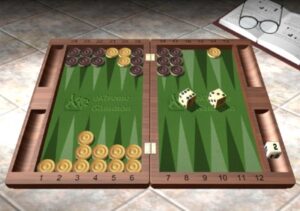Cash game, White owns the cube.

White to play 6-3.
Checker play in holding games is generally a pretty simple matter. When you’re holding onto an anchor and you’re way behind in the race, you try to follow three rules:
1) Keep your anchor as long as you can.
2) Run off your anchor when the alternative is breaking your board.
3) Run off the anchor if staying raises your gammon chances a lot.
If you’re familiar with these rules, you’ll be able to handle most normal holding game positions well.
Things get trickier when you have a third checker back. The third checker can generate more potential shots; it can also get you gammoned if Black can point on the checker and you get stuck on the bar a long time. This position shows a typical situation: Should White stay to get more shots, or run to eliminate gammon chances?
The simple answer is this: When in doubt, stay and try to win. Running minimizes both your wins and your gammon losses, while maximizing your single losses. Staying coverts single losses into a mixture of extra wins and extra gammon losses. Converting a loss into a win gains four points (-2 to +2), while converting a loss into a gammon loss loses only two additional points (-2 to -4). That’s an extremely favorable risk-reward ratio: you’d need to lose more than two extra gammons for every extra win for running to be correct.
In this position, playing 14/5 and keeping the spare checker on the 21-point gets you four immediate shot numbers (6-3 and 5-3) while forcing Black to play awkwardly with some of his fours (with 6-4 and 5-4 he’ll clear his 7-point rather than his 8-point.) Even when Black rolls perfectly and makes his 4-point on your head, he’ll often leave a few indirect shots to cushion the blow. That’s a lot of immediate gain by staying back, so you’ll have to be very sure you’re getting gammoned a lot when you stay to justify running.
Now let’s put some hard numbers on these ideas by turning to some rollouts. We’ll start by looking at the running plays, 21/12 and 21/15 14/11, which are essentially the same play. If White chooses to run, here’s what happens:
White wins the game: 9.3%
White loses a gammon: 2.3%
White loses a single game: 88.4%
The figure of 9.3% White wins may seem high, but you can justify it pretty easily as follows. Imagine that Black successfully clears the 8-point and 7-point, leaving him with just two checkers on his 6-point against Black’s anchor. He then leaves a shot with 6-1 and 5-1, a total of four rolls, about 11% of the time. White hits 30% of these, or about 3.3%. If Black doesn’t have a checker on his 4-point when he’s trying to clear his 6-point, then 4-1 also leaves a shot, boosting the shot percentage to almost 17% and the hit percentage to about 5.5%.
Black has two other points to clear besides his 6-point, and he may leave a shot there as well, so we’ll need to add a few extra per cent for that. In addition, White still has about a 1% chances in a straight race after he plays his 6-3. Add all these factors together, and the 9.3% winning chances look pretty reasonable.
If White stays in Black’s board and elects to play 14/5 instead, the percentages change as follows:
White wins the game: 18%
White loses a gammon: 15.7%
White loses a single game: 66.3%
By staying, White almost doubles his win percentage, gaining 8.7% additional wins, and increases his chance of being gammoned more than six times, from 2.3% to 15.7%, an increase of 13.4% additional gammon losses. Even though that’s a huge percentage increase in gammons, it’s still less than double the increase in additional wins, so the aggressive play of staying back and playing for the win is dominant.
How much better would Black’s position need to be to make running or staying a tossup? Take a look at Position A.

Position A: White to play 6-3.
The extra Black builders on the 7-point and 8-point benefit Black’s game in a couple of ways: he has no shot numbers on the first turn, and he will have multiple chances to point on White before starting to break points. Even with that, however, running and staying are now equivalent choices.





